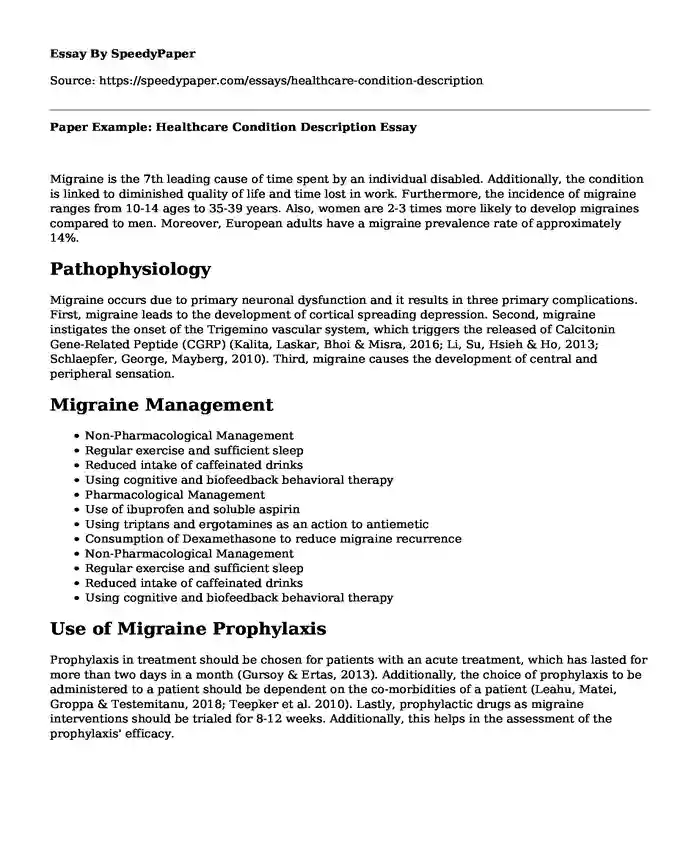
| Type of paper: | Essay |
| Categories: | Medicine Pharmacology Mental disorder |
| Pages: | 3 |
| Wordcount: | 595 words |
Migraine is the 7th leading cause of time spent by an individual disabled. Additionally, the condition is linked to diminished quality of life and time lost in work. Furthermore, the incidence of migraine ranges from 10-14 ages to 35-39 years. Also, women are 2-3 times more likely to develop migraines compared to men. Moreover, European adults have a migraine prevalence rate of approximately 14%.
Pathophysiology
Migraine occurs due to primary neuronal dysfunction and it results in three primary complications. First, migraine leads to the development of cortical spreading depression. Second, migraine instigates the onset of the Trigemino vascular system, which triggers the released of Calcitonin Gene-Related Peptide (CGRP) (Kalita, Laskar, Bhoi & Misra, 2016; Li, Su, Hsieh & Ho, 2013; Schlaepfer, George, Mayberg, 2010). Third, migraine causes the development of central and peripheral sensation.
Migraine Management
- Non-Pharmacological Management
- Regular exercise and sufficient sleep
- Reduced intake of caffeinated drinks
- Using cognitive and biofeedback behavioral therapy
- Pharmacological Management
- Use of ibuprofen and soluble aspirin
- Using triptans and ergotamines as an action to antiemetic
- Consumption of Dexamethasone to reduce migraine recurrence
- Non-Pharmacological Management
- Regular exercise and sufficient sleep
- Reduced intake of caffeinated drinks
- Using cognitive and biofeedback behavioral therapy
Use of Migraine Prophylaxis
Prophylaxis in treatment should be chosen for patients with an acute treatment, which has lasted for more than two days in a month (Gursoy & Ertas, 2013). Additionally, the choice of prophylaxis to be administered to a patient should be dependent on the co-morbidities of a patient (Leahu, Matei, Groppa & Testemitanu, 2018; Teepker et al. 2010). Lastly, prophylactic drugs as migraine interventions should be trialed for 8-12 weeks. Additionally, this helps in the assessment of the prophylaxis' efficacy.
Conclusion
In conclusion, migraine is the 7th leading cause of time spent by an individual disabled and its incidence ranges from 10-14 ages to 35-39 years. Also, women are 2-3 times more likely to develop migraines compared to men and European adults have a migraine prevalence rate of approximately 14%. Migraine occurrence leads to the development of cortical spreading depression, the onset of the Trigemino vascular system and the development of central and peripheral sensation. Migraine can be treated using pharmacologic and non-pharmacologic treatment. Prophylaxis in treatment should be chosen for patients with an acute treatment, which has lasted for more than two days in a month. Additionally, the choice of prophylaxis to be administered to a patient should be dependent on the co-morbidities of a patient. Lastly, prophylactic drugs as migraine interventions should be trialed for 8-12 weeks. Additionally, this helps in the assessment of the prophylaxis' efficacy.
References
Kalita, J., Laskar, S., Bhoi, S. K., & Misra, U. K. (2016). Efficacy of single versus three sessions of high rate repetitive transcranial magnetic stimulation in chronic migraine and tension-type headache. Journal of Neurology, 2016 (263), 2238-2246. doi:10.1007/s00415-016-8257-2
Leahu, P., Matei, A., Groppa, S., & Testemitanu, N. (2018). Transcranial magnetic stimulation in migraine prophylaxis. Journal of Medicine and Life, 11 (2), 175-176.
Li, C.-T., Su, T.-P., Hsieh, J.-C., & Ho, S.-T. (2013). Efficacy and practical issues of repetitive transcranial magnetic stimulation on chronic medically unexplained symptoms of pain. Acta Anaesthesiologica Taiwanica, 51 (2003), 81-87. doi:10.1016/j.aat.2013.06.003
Teepker, M., Hotzel, J., Timmesfeld, N., Reis, J., Mylius, V., Haag, A., et al. (2010). Low-frequency rTMS of the vertex in the prophylactic treatment of migraine. Cephalalgia: An International Journal of Headache, 30 (2), 137-144. doi: 10.1111/j.1468-2982.2009.01911.x
Schlaepfer, T. E., George, M. S. & H. Mayberg (2010). On behalf of the WFSBP Task Force on Brain Stimulation WFSBP Guidelines on Brain Stimulation Treatments in Psychiatry, The World Journal of Biological Psychiatry, 11:1, 2-18, doi:10.3109/15622970903170835
Gursoy, A. E., & Ertas, M. (2013). Prophylactic Treatment of Migraine. Noro Psikiyatri Arsivi, 50 (Suppl. 1), S30-S35. doi:10.4274/npa.y7199
Cite this page
Paper Example: Healthcare Condition Description. (2023, Mar 21). Retrieved from https://speedypaper.com/essays/healthcare-condition-description
Request Removal
If you are the original author of this essay and no longer wish to have it published on the SpeedyPaper website, please click below to request its removal:
- Essay Example on Essential Public Health Services
- Free Essay Sample about National Health Status
- Japanese Culture Essay Sample
- Essay Sample: Free Will of Choices in Life
- Ethical Intuitionism, Divine Command Theory, and Utilitarianism - Essay Example
- "Reflection on the End of Racial Representation" Chapter Discussion Essay Sample
- IBM in the United Kingdom and South Korea. Essay Example
Popular categories




